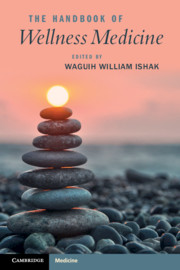Book contents
- The Handbook of Wellness Medicine
- The Handbook of Wellness Medicine
- Copyright page
- Dedication
- Contents
- Contributors
- Part I Approach to Wellness
- Part II From Illness to Wellness by Organ Systems/Disorders
- Chapter 6 The Concept of Wellness in Psychiatric and Substance-Use Disorders
- Chapter 7 Neurological and Neurosurgical Disorders and Wellness
- Chapter 8 Cardiovascular and Pulmonary Wellness
- Chapter 9 Gastrointestinal System and Wellness
- Chapter 10 Wellness and the Genito-Urinary System
- Chapter 11 Reproductive System
- Chapter 12 Allergic, Infectious, and Immunological Processes
- Chapter 13 Wellness in Endocrine and Metabolic Disorders
- Part III Special Populations and Special Topics
- Part IV Wellness Interventions
- Part V Wellness through Optimization of Work, Love, and Play
- Book part
- Index
- References
Chapter 10 - Wellness and the Genito-Urinary System
from Part II - From Illness to Wellness by Organ Systems/Disorders
Published online by Cambridge University Press: 18 September 2020
- The Handbook of Wellness Medicine
- The Handbook of Wellness Medicine
- Copyright page
- Dedication
- Contents
- Contributors
- Part I Approach to Wellness
- Part II From Illness to Wellness by Organ Systems/Disorders
- Chapter 6 The Concept of Wellness in Psychiatric and Substance-Use Disorders
- Chapter 7 Neurological and Neurosurgical Disorders and Wellness
- Chapter 8 Cardiovascular and Pulmonary Wellness
- Chapter 9 Gastrointestinal System and Wellness
- Chapter 10 Wellness and the Genito-Urinary System
- Chapter 11 Reproductive System
- Chapter 12 Allergic, Infectious, and Immunological Processes
- Chapter 13 Wellness in Endocrine and Metabolic Disorders
- Part III Special Populations and Special Topics
- Part IV Wellness Interventions
- Part V Wellness through Optimization of Work, Love, and Play
- Book part
- Index
- References
Summary
The focus of this chapter about the genito-urinary (GU) system is evidence-based information on how to support health and wellness of the urinary system in general, as well as during recovery from a urologic condition. It is widely accepted that diet, exercise, lifestyle, and behavior affect overall health by impacting organ systems. The impact of wellness medicine on the GU tract is less recognized and less robustly studied, but the principles remain important and impactful. This chapter will discuss: bladder health, including overactive bladder, urinary incontinence, and urinary tract infections; sexual health; prostate health, including benign prostatic hyperplasia and prostate cancer; and kidney health, including kidney stones.
- Type
- Chapter
- Information
- The Handbook of Wellness Medicine , pp. 98 - 115Publisher: Cambridge University PressPrint publication year: 2020



